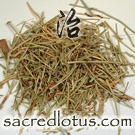Ma Huang (Ephedra Stem)
Herb 8 of 16 in Warm, Spicy Herbs that Release the Exterior
Buy This Herb
Get free shipping from
our partners at CHD
our partners at CHD
Chinese Herb Actions
-
Releases the Exterior and Disperses Wind-Cold
For Wind-Cold excess patterns with fever, chills, headache, lack of sweating, and a tight, floating pulse. Opens the pores and induces sweating. - Stops Wheezing and Asthma
Obstruction of Lung Qi due to exterior Wind-Cold or wheezing from an internal condition. - Reduces Edema and Promotes Urination
Especially due to obstruction from external Wind-Cold pathogen.
Chinese Herb Contraindications & Cautions
- Long-term or overuse causes heavy sweating and weakens the body. May also raise blood pressure, do not use if patient has insomnia, spontaneous sweating, high blood pressure, or cardiac arrhythmias. Toasting with honey reduces the dispersing nature of this herb.
Herb-Drug Interactions
- Ma Huang contains ephedrine and pseudoephedrine which interferes with Sympathomimic (anti-seizure) and Cariovascular drugs.
- Ma Huang (Ephedra) and MAOI can cause dangerously high blood pressure. FDA proposed a dosage limit of 8 mg every 6 hours (or a total of 24 mg per day) and not more than 7 days of continuous use.
Chinese Herb Toxicity & Overdose
- There has been 3 reported cases of ephedrine toxicity, after ingestion of 15ml of a 1% solution. Symptoms included diaphoresis, epigastric pain, vomiting, nausea, and temperature elevation.
- Section not completed...
Chinese Herb Dosage
- 3-9 grams.
- Part used: Twigs or stems.
Chinese Herb Notes
- Cook first and remove foam from the surface of decoction.
- Use raw for exterior wind-cold, coat with honey to treat asthma.
This Herb Appears in the Following Formulas:
- Die Da Wan (Trauma Pill)
Category: Formulas that Invigorate the Blood in the Treatment of Traumatic Injury - Ding Chuan Tang (Arrest Wheezing Decoction)
Category: Formulas that Direct Rebellious Qi Downward - Fang Feng Tong Sheng San (Ledebouriella Powder that Sagely Unblocks)
Category: Formulas that Release Exterior-Interior Excess - Ge Gen Tang (Kudzu Decoction)
Category: Formulas that Release Exterior Disorders with Head and Neck Symptoms - Gui Zhi Shao Yao Zhi Mu Tang (Cinnamon Twig, Peony, and Anemarrhena Decoction)
Category: Formulas that Dispel Wind-Dampness - Ma Huang Tang (Ephedra Decoction)
Category: Formulas that Release Exterior Cold - Ma Huang Xi Xin Fu Zi Tang (Ephedra, Asarun, and Prepared Aconite Decoction)
Category: Formulas that Release Exterior Disorders with Interior Deficiency - Ma Xing Shi Gan Tang (Ephedra, Apricot Kernel, Gypsum, and Licorice Decoction)
Category: Formulas that Clear Heat from the Organs - Shi Gao Tang (Gypsum Decoction)
Category: Formulas that Release Exterior-Interior Excess - Wu Ji San (Five Accumulation Powder)
Category: Formulas that Release Exterior-Interior Excess - Xiao Qing Long Tang (Minor Bluegreen Dragon Decoction)
Category: Formulas that Release Exterior Cold - Xiao Xu Ming Tang (Minor Prolong Life Decoction)
Category: Formulas that Release Wind from the Skin and Channels - Yang He Tang (Yang Heartening Decoction)
Category: Formulas that Warm the Channels and Disperse Cold
This herb is considered endangered, toxic, or is illegal in the United States






